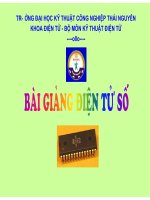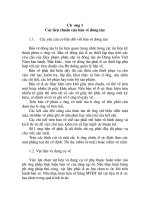Bai giang ve mau (Blood)
Bạn đang xem bản rút gọn của tài liệu. Xem và tải ngay bản đầy đủ của tài liệu tại đây (900.94 KB, 44 trang )
Blood
Specific terms
hemo-/haemo
Hay hemato/ haemato-H(a)ematology
-Hemoglobin
-Hemocyanin
-Hemato-biochemical parameters
-Hematopoiesis
Blood
-
Functions of the blood
Components of the blood
Erythrocyte/red blood cell and its structure and
Erythropoiesis and Eryptosis
Leucocyte/white blood cell types and functions
Hemostasis and blood clotting, the role of Ca2+, vitamin K and
liver in hemostasis
- ABO and Rh blood group systems
Blood volume in animals
• Blood is a fluid connective tissue
• 70-80 ml/kg (7- 8%-4,5 l) - human
Blood Volumes of Healthy Adult Animals*
Species
Volume (ml/kg)
Cat
55 (47-66)
Dog
86 (79-90)
Ferret
75
Gerbil
67
Goat
70
Guinea Pig
75 (67-92)
Hamster 78
Monkey (rhesus)
54
Mouse
79 (78-80)
Pig
65
Rabbit
56 (44-70)
Rat
64 (50-70)
Sheep
60
*Can be 15% less in obese and old animals
/>
Components of the blood
•Plasma (Huyết tương): the
remaining fluid in the blood after
removing all blood cells
Plasma (55%)
•Formed elements:
─ erythrocyte (red bllod cell)
─ leucocyte (white blood cell)
Leucocyte, plateletes
─ Platelet
Erythrocyte (45%)
Hematocrit (hct)= 100 x (erythrocyte volume/ total blood volume)
Functions of the blood
• Transport: nutrients, respiratory gases,
metabolic wastes, hormones
• Maintaining homeostasis for: pH, temperature,
electrolyte balance
• Protection: blood clotting, immune response
Osmotic pressure and pH of the blood
• Osmotic pressure - P = 7,6 - 8,1 atm (human)
• Created by salts (NaCl) + dissolved proteins
• pH = 7,35 - 7,45, is maintained by different
buffering systems
Red blood cells and changes in plasma osmotic
pressure
Dd ưu trương
Cell shrinks
Dd đẳng trương
normal
Dd nhược trương
Cell swells
Components of plasma
Formed elements (Các yếu tố hữu hình)
• Erythrocyte (Hồng cầu ):
95%
• Leucocyte (Bạch cầu ) 5%
• Platelet/thrombocyte
(Tiểu cầu)
/>
Erythrocyte
•3,2 - 5 million /mm3 of blood (700x
of leucocyte, of platelets);
7,5µm
2 µm
•Biconcave shape -> 1.63 x larger
in surface
•No nucleus, no mitochondria
•Function: transport of O2, CO2,
maintaining osmolarity and pH of
the blood
•Hemoglobin: 1/3 volume of an
erythrocyte (250 million Hb
molecules /1 erythrocyte)
Hemoglobin (Hb)
Hemoglobin
molecule
Hem group
O
2
2/3 the amount of iron in the body is contained in red blood
cells
The life span of red blood cell
• 1 second: 2.5 million are destroyed/degraded 2.5
million are produced
• Erythropoiesis (sự
tạo hồng cầu):
– Life span: 120 days (male), 110 days (female)
– Site of erythropoiesis: liver, spleen (during
embryogenesis), bone marrow (aldult)
– 4 days to form a new red blood cell
erythropoiesis
Hemocytoplast
proerythroblast
Basophilic erythroblast
Polychromatic erythroblast
normoblast
enucleated
reticulocyte
Removal of ribosome
erythrocyte
Nguồn: cải biên từ Seeley, 2000
4 days
Factors regulate erythropoiesis
Erythropoietin
(EPO)
EPO
• acid folic,
• B12,
• Fe
Nguồn: />
Anemia and blood doping
Anemia: decrease in the oxygen carrying capacity of blood:
•
•
•
•
•
•
- Decrease in number and size of erythrocytes -> low hematocrit
- Decrease in Hb level in each erythrocyte
Nutritional anemia (iron, folic acid, B12 deficiency)
Pernicious anemia (lack of intrinsic factor needed for B12 absorption)
Aplastic anemia (bone marrow deffect)
Renal anemia (lack EPO)
Hemorrhagic anemia
Hemolytic anemia (malaria, sickle cell anemia)
Blood doping: injection of erythrocytes or EPO to increase the
oxygen carrying capacity of blood
Eryptosis (sự phân hủy hồng cầu)
Most of old erythrocytes are phagozied by macrophages
in the spleen and to a lesser extent, in the livers
Hemoglobin
Macrophage
Hem
Globin
Jaundice
/>2010/10/jaundice.html
Biliverdin
Bilirubin
Fe
a.a
2+
Bilirubin
New protein
synthesis
Albumin
Spleen(storage)
Bone marrow
(form new red blood
cells)
Bile
Feces
urine
Leucocytes/white blood cells
•
•
•
•
Have larger
size than
RBC: 5 – 25 µm
Less numerous than RBC: 7000 – 8000/mm3
(adult), 20.000/mm3 (infant)
Irregular cell shape, nucleated and mobile cells
Specific and nonspecific immune response
Types of leucocytes
leucocyte
granulocytes
agranulocytes
Trung tính
Ưa acid
Ưa kiềm
Đơn nhân
Bạch huyết bào
Neutrophil
Eosinophil
Basophil
Monocyte
Lymphocyte
1-4%
50-80%
-10-15 µm
-9%
-10-15 µm
- 20-40%
-10-15 µm
-2-8%
- nonphagocytic ,
-15 - 25 µm
- 5-15 µm
- T,B Lymphocyte
producing toxic
weak
phagocytosis
to
-Phagocytosis
molecules against -Phagocytosis
parasites by producing
Macrophage - antigen producing
larger parasites;
toxic molecules
Dennis Kunkel, 2004
Platelets and Hemostasis
platelets
platelets/ thrombocytes (Tiểu cầu)
– Are cell fragments generated by breaking off of
megakaryocyte (100 µm) in bone marrow
– 3 µm, 100.000 – 500.000/ mm3 of blood,
– Have mitochondria, smooth endoplasmic reticulum,
cytoplasmic granules but no nucleus
– contain actin, myosin in the cytosol
– Lifespan: 5-9 days
SEM (scanning electron microscope)
images of megakaryocyte and platelet
Magnification:* x1,600
a large megakaryocyte is
forming 2 small platelets
Magnification:* x5,335
A mature platelet
Hemostasis
Collagen exposing
1
Platelet plug
2
Fibrin clots
3
1. Vascular spasm
2. Formation of Platelet plug
3. Formation of Blood clot (thrombus):
platelets + fibrin + blood cells
Vascular spasm (Sự co thắt mạch) starts
the process of hemostasis
• intrinsic mechanisms and increased
sympathetic neural activities cause
vasoconstriction (vascular spasm) of the
damaged blood vessels -> reducing blood
loss









